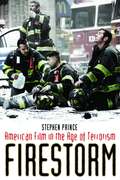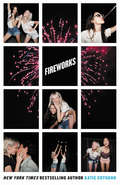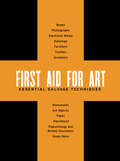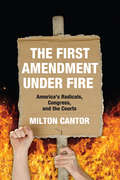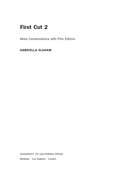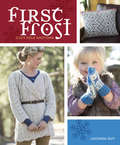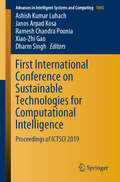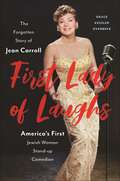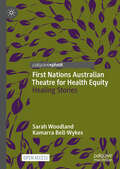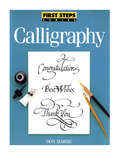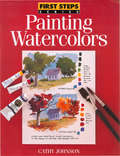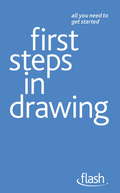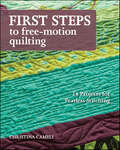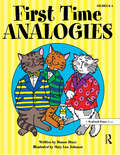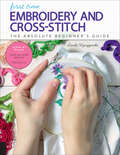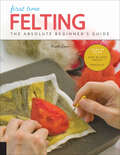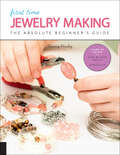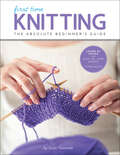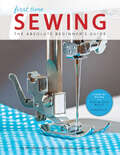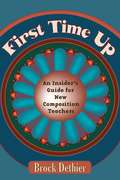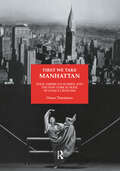- Table View
- List View
Firestorm: American Film in the Age of Terrorism
by Stephen PrinceIt was believed that September 11th would make certain kinds of films obsolete, such as action thrillers crackling with explosions or high-casualty blockbusters where the hero escapes unscathed. While the production of these films did ebb, the full impact of the attacks on Hollywood's creative output is still taking shape. Did 9/11 force filmmakers and screenwriters to find new methods of storytelling? What kinds of movies have been made in response to 9/11, and are they factual? Is it even possible to practice poetic license with such a devastating, broadly felt tragedy?Stephen Prince is the first scholar to trace the effect of 9/11 on the making of American film. From documentaries like Fahrenheit 9/11 (2004) to zombie flicks, and from fictional narratives such as The Kingdom (2007) to Mike Nichols's Charlie Wilson's War (2007), Prince evaluates the extent to which filmmakers have exploited, explained, understood, or interpreted the attacks and the Iraq War that followed, including incidents at Abu Ghraib. He begins with pre-9/11 depictions of terrorism, such as Alfred Hitchcock's Sabotage (1936), and follows with studio and independent films that directly respond to 9/11. He considers documentary portraits and conspiracy films, as well as serial television shows (most notably Fox's 24) and made-for-TV movies that re-present the attacks in a broader, more intimate way. Ultimately Prince finds that in these triumphs and failures an exciting new era of American filmmaking has taken shape.
Fireworks
by Katie CotugnoFrom the New York Times bestselling author of 99 Days and How to Love comes a stunning new contemporary novel—all about boy bands, girl bands, best friends, and first love—perfect for fans of Sarah Dessen and Morgan Matson. It was always meant to be Olivia. She’s the talented one, the one who’s been training to be a star her whole life. Her best friend, Dana, is the levelheaded one, always on the sidelines, cheering Olivia on.But everything changes when Dana tags along with Olivia to Orlando for the weekend, where superproducer Guy Monroe is holding auditions for a new singing group, and Dana is discovered too. Dana, who’s never sung more than Olivia’s backup. Dana, who wasn’t even looking for fame. Next thing she knows, she and Olivia are training to be pop stars, and Dana is falling for Alex, the earnest, endlessly talented boy who’s destined to be the next big thing.It should be a dream come true, but as the days of grueling practice and constant competition take their toll, things between Olivia and Dana start to shift . . . and there’s only room at the top for one girl. For Olivia, it’s her chance at her dream. For Dana, it’s a chance to escape a future that seems to be closing in on her. And for these lifelong best friends, it’s the adventure of a lifetime—if they can make it through. Set in evocative 1990s Orlando, Fireworks brings to life the complexity of friendship, the excitement of first love, and the feeling of being on the verge of greatness.
First Aid for Art
by Jane K. Hutchins Barbara O. RobertsWhen disaster strikes, the first few hours are critical to saving art, artifacts and important objects. This ebook, written by highly regarded professional museum conservators, outlines procedures and techniques to help improve the chances of rescuing artworks, photographs, books, memorabilia, textiles, and furniture from catastrophic damage. Although not a manual on formal art conservation, this ebook will help you to organize materials, time and tasks to make decisions when triage is the only option. Presented with graphic clarity, this handy publication will provide welcome guidance to non-specialists and professionals alike.Treatments are organized into twelve chapters, each dealing with a particular medium. Pared to the essentials, the chapters begin with an introduction about the properties and treatment of common materials. This is followed by a description of what to anticipate and how to determine immediate and deferred action. Suggestions for stabilizing materials until professional assistance is available are outlined. Concluding each chapter is a brief list of supplies. The book includes an appendix of professional resources.
First Amendment Under Fire: America's Radicals, Congress, and the Courts
by Milton CantorThe First Amendment is perhaps the most important - and most debated - amendment in the US Constitution. It establishes freedom of speech, as well as that of religion, the press, peaceable assembly and the right to petition the government. But how has the interpretation of this amendment evolved? Milton Cantor explores America's political response to the challenges of social unrest and how it shaped the meaning of the First Amendment throughout the twentieth century. This multi-layered study of dissent in the United States from the early 1900s through the 1970s describes how Congress and the law dealt with anarchists, syndicalists, socialists, and militant labor groups, as well as communists and left-of-center liberals. Cantor describes these organizations' practices, policies, and policy shifts against the troubled background of war and overseas affairs. The volume chronologically explores each new challenge - both events and legislation - for the First Amendment and how the public and branches of government reacted. The meaning of the First Amendment was defined in the crucible of threats to national security. Some perceived threats were wartime events; the First World War instigated awareness of civil liberties, but in those times, security trumped liberty. In the peace that followed, efforts to curtail speech continued to prevail. Cantor analyzes the decades-long divisiveness regarding First Amendment decisions in the Supreme Court, coming down squarely in criticism of those who have argued for greater government control over speech.
First Art for Toddlers and Twos: Open-Ended Art Experiences
by Maryann KohlDiscover the natural curiosity and enthusiasm of toddlers and twos as they explore creative art experiences designed just for them. In this updated, color edition of First Art for Toddlers and Twos, you will find more than seventy-five art experiences, with lots of variations that add to the fun and tips for making the activities run smoothly. First Art for Toddlers and Twos starts children on a journey full of exploration and creativity!
First Book of Modern Lace Knitting
by Marianne KinzelEven the average knitter can now begin to knit in modern lace patterns -- "Celandine," "Mosaic," "Rose Leaf," "Candlelight," "Coronet," "Valentine," "Azalea," "Primula," "Sun Ray," "English Crystal," "Springtime," "Three of Hearts" -- all by well-known modern lace designer Marianne Kinzel. What is especially attractive about Mrs. Kinzel's approach is not only her fine knitted lace designs but also the comparatively short time and low cost involved in accomplishing each project.Marianne Kinzel, well known to knitters in the United Kingdom and the United States, has long been looked to for her gift for clear presentation and even more so for her ability in devising original designs. She begins with a chapter on the fundamentals of lace knitting, covering everything the average knitter needs to know to begin working in lace. Other chapters give detailed instructions for projects in two-needle, round, and square techniques. Over 25 distinctive lace projects are presented, including luncheon sets, tray and table cloths, curtains, cushion covers, chair backs, and doilies. Instructions are presented both in the traditional written method and in the chart-and-symbol method. There are keys to the charts in English, French, and German, lavish and helpful illustrations, and sound practical advice on knitting techniques, finishing, and laundering. There are also instructions on altering the patterns to your own special needs. Perfect for the beginning lace knitter or the advanced professional, Marianne Kinzel's lace patterns make well-suited gifts and items for around the home.
First Cut 2
by Gabriella OldhamFirst Cut 2: More Conversations with Film Editors presents a new collection of twelve interviews with award-winning film editors who discuss the art and craft of editing in the twenty-first century. As a follow-up to the successful First Cut: Conversations with Film Editors (now celebrating its 20th anniversary), this new volume explores the transition of editing from the age of celluloid to the digital age. These extraordinarily articulate editors share their passion about film, offer detailed practical examples from their films to explain their process as well as their challenges, and imbue each interview with unique personality, humor, and cinematic insights. First Cut 2 continues the tradition of the first volume by interviewing both fiction and documentary editors, contributing to a rich, holistic appreciation of editing. It also introduces a significant interview with an independent filmmaker/editor to emphasize today's multiple opportunities for aspiring filmmakers to make their own "small films" and achieve success. Together with the first volume, First Cut 2 offers a panoramic survey of film editing and preserves its history through the voices of its practitioners. The stories told will engage students, inform general filmgoers, and even enlighten industry professionals.
First Frost: Cozy Folk Knitting
by Lucinda GuyDiscover traditional northern European knitting techniques to create modern garments. Lucinda Guy follows up her recent successes with another exploration of northern European knitting, this time expanding to include Nordic, Baltic, and Scandinavian heritage knitting traditions. This latest collection includes full-sized garments as well as accessories for women, men, children, and home and contains 20 pieces total. First Frost: Cozy Folk Knitting celebrates all that is wonderful about decorative folk knitting. As essential everyday wear for anyone living and working in the harsh, cold climates of the North, folk knits could range from the simple and utilitarian to textural, braided, tasseled, and exuberantly colored and patterned knits reserved only for special occasions and celebrations. Lucinda turns historic knitting traditions into everyday wear that is folk-inspired but never costumey and brings heritage knitting techniques to a modern audience.
First International Conference on Sustainable Technologies for Computational Intelligence: Proceedings of ICTSCI 2019 (Advances in Intelligent Systems and Computing #1045)
by Xiao-Zhi Gao Dharm Singh Ashish Kumar Luhach Janos Arpad Kosa Ramesh Chandra PooniaThis book gathers high-quality papers presented at the First International Conference on Sustainable Technologies for Computational Intelligence (ICTSCI 2019), which was organized by Sri Balaji College of Engineering and Technology, Jaipur, Rajasthan, India, on March 29–30, 2019. It covers emerging topics in computational intelligence and effective strategies for its implementation in engineering applications.
First Lady of Laughs: The Forgotten Story of Jean Carroll, America's First Jewish Woman Stand-Up Comedian
by Grace Kessler OverbekeBefore Hacks and The Marvelous Mrs. Maisel, there was the comedienne who started it allFirst Lady of Laughs tells the story of Jean Carroll, the first Jewish woman to become a star in the field we now call stand-up comedy. Though rarely mentioned among the pantheon of early stand-up comics such as Henny Youngman and Lenny Bruce, Jean Carroll rivaled or even outshone the male counterparts of her heyday, playing more major theaters than any other comedian of her period. In addition to releasing a hit comedy album, Girl in a Hot Steam Bath, and briefly starring in her own sitcom on ABC, she also made twenty-nine appearances on The Ed Sullivan Show. Carroll made enduring changes to the genre of stand-up comedy, carving space for women and modeling a new form of Jewish femininity with her glamorous, acculturated, but still recognizably Jewish persona. She innovated a newly conversational, intimate style of stand-up, which is now recognized in comics like Joan Rivers, Sarah Silverman, and Tiffany Haddish. When Carroll was ninety-five she was honored at the Friars Club in New York City, where celebrities like Joy Behar and Lily Tomlin praised her influence on their craft. But her celebrated career began as an impoverished immigrant child, scrounging for talent show prize money to support her family. Drawing on archival footage, press clippings, and Jean Carroll’s personal scrapbook, First Lady of Laughs restores Jean Carroll’s remarkable story to its rightful place in the lineage of comedy history and Jewish American performance.
First Nations Australian Theatre for Health Equity: Healing Stories
by Sarah Woodland Kamarra Bell-WykesILBIJERRI Theatre Company is Australia's longest established First Nations theatre company, producing powerful works for over 30 years. This open access book documents and critically reflects on their Social Impact stream of performances, aimed at health promotion and education around issues that disproportionately affect First Nations communities in Australia. Over the past 16 years, these works have reached over 25,000 audience members across the country. Productions include 'Chopped Liver' (2006-2009), 'Body Armour' (2011-2013) and 'Viral' (2018-2019)—all dealing with Hepatitis C; 'North West of Nowhere' (2014-2016), which deals with sexual health and healthy relationships; and 'Scar Trees' (2019), which addresses family violence. A new work, ‘Aunty Flo’ (2022) addresses menopause for First Nations women; and a pilot project addressing sexual health for First Nations young people—The Score (2022)—represents a new participatory approach to the Social Impact works, which places community members at the centre of the storytelling process. This book documents this important body of work for the first time, examining the impact on audiences and the cultural, aesthetic, and educational implications of a unique form of theatre for health education and promotion.
First Steps Calligraphy (First Steps)
by Don MarshMake your first steps in calligraphy fun and rewarding! You'll be delighted at how easy this guide makes it to address invitations with a touch of class, send unforgettable greeting cards, and craft unique and meaningful gifts. With Don Marsh's simple and straightforward instruction, you'll be creating graceful handwritten expressions in no time! By learning a few key strokes (most of them found in the letters "a" and "n") you'll be able to form all the letters of the alphabet. In this book, you'll find everything you need to begin-including: Which tools and materials to buy to get off to a good, affordable start Easy-to-follow instructions for the most practical and popular lettering styles-simple italic minuscules, simple roman capitals, simple italic capitals and swash caps Easy (but effective) exercises that make learning fun How to create numerals and decorative flourishes Copy-and-use practice sheets Inspiring examples of the art of calligraphy More than a dozen projects-complete with stroke-by-stroke instruction-show you different ways to apply your new skills. You'll find practical and imaginative ideas for greeting cards, invitations, romantic verse and much more. And with Don's help, you can get started right away.
First Steps Painting Watercolors: How To Use Special Watercolor Techniques To Capture Nature's Unnoticed Wonders (First Steps)
by Cathy JohnsonMake your first steps in watercolor fun and rewarding! Watercolor's vivid colors and fresh, direct brush strokes make it the most exciting way to paint. "But," you think, "Learning to paint must be hard and frustrating." Not with Cathy Johnson as your teacher! Here, she makes learning to paint in watercolor fun-even easy! With Painting Watercolors, you'll learn to paint by picking up a brush and painting-not by reading about a bunch of confusing theories. Cathy tells you everything you need to begin-including: Which tools and materials you should buy to get off to a good, affordable start When, what, even where to paint Explanations of watercolor terms (such as "washes" and "puddles") Easy and useful painting tricks-such as glazing and drybrush. Exercises help you loosen up and learn the ins and outs of putting paint on paper. Easy-to-follow, step-by-step instructions show you how to paint water, believable skies, a variety of trees in different seasons and other popular elements. Plus, a dozen demonstrations show you how paintings come together, from initial sketch to final brushstrokes. With Cathy's help, you can start painting right away!
First Steps in Drawing: Flash
by Robin CaponThe books in this bite-sized new series contain no complicated techniques or tricky materials, making them ideal for the busy, the time-pressured or the merely curious. First Steps in Drawing is a short, simple and to-the-point guide to learning the basic principles of drawing in a few short steps. Whether sketching people, places, buildings or just generally, in just 96 pages you will discover how to master the essential principles and create captivating and memorable work.
First Steps in Drawing: Flash
by Robin CaponThe books in this bite-sized new series contain no complicated techniques or tricky materials, making them ideal for the busy, the time-pressured or the merely curious. First Steps in Drawing is a short, simple and to-the-point guide to learning the basic principles of drawing in a few short steps. Whether sketching people, places, buildings or just generally, in just 96 pages you will discover how to master the essential principles and create captivating and memorable work.
First Steps to Free-Motion Quilting: 24 Projects for Fearless Stitching
by Christina CameliBaby steps to awesome quilting • Just start stitching! Practice free-motion quilting with 24 easy-to-achieve projects • You’ll make simple quilts, embellish kitchen towels and clothes, personalize a messenger bag, and so much more • All projects are freehand and require no marking Ready, set, sew! Learn the basics, gather your supplies, pick a project, and start stitching. With a refreshingly new approach to free-motion stitching, First Steps to Free-Motion Quilting encourages you to make something beautiful while improving your free-motion quilting skills. You’ll find 24 projects and quilts that are light on assembly so you can spend most of your time stitching. A handy troubleshooting guide ensures success every step of the way.
First Time Analogies: Grades K-2
by Dianne DrazeAn analogy is a comparison between two things. It points out the similarities between two things that might be different in all other respects. Analogies cause us to think analytically about forms, uses, structures, and relationships. First Time Analogies is the ideal launching pad to start nonreaders on the road to real thinking experiences with these pictorial and symbolic analogies that are both challenging and motivating. The book is divided into four sections that let you introduce analogies in a developmental way. The levels are: recognizing relationships; choosing one item to complete the analogy; given two items, choosing two other items that have the same relationships; and pairing up four items to complete two related pairs. Exercises are presented on worksheets that require circling the correct answer, as well as cutting out pictures and pasting them in the correct spaces. Attractive illustrations will draw students into the engaging exercises. Although they think they are just solving fun puzzles, they will be doing serious thinking and building a basis for future experiences in critical thinking. This is the first in a series of books that introduce analogies at varying difficulties and formats. The other books are Analogies for Beginners, Analogies for the 21st Century, Thinking Through Analogies, and Advancing Though Analogies. Grades K-2
First Time Embroidery and Cross-Stitch: The Absolute Beginner's Guide
by Linda WyszynskiA beginner’s step-by-step, photo-filled guide to the basics of embroidery, crewel, and cross stitch, with exciting projects to get you started.This beginner’s guide, by embroidery professional Linda Wyszynski, uses easy-to-follow, photo-illustrated instruction to teach you the basics of classic embroidery, crewel, and cross-stitch techniques. In no time, you can use these methods to create beautiful, personalized designs.After a review of equipment and supplies, fabrics, threads, patterns, and stitching basics, jump right in with these step-by-step projects:Creative embroidery—Embroidered Jacket Collar and Embellished Pillow CaseCrewel—Paisleys and Pearls Pillow and Touch of Gold Fedora HatCross-Stitch—Violet Blossoms Candle Band and Springtime JournalThere’s a first time for everything. Enjoy the journey and achieve success with First Time Embroidery and Cross-Stitch.
First Time Felting: The Absolute Beginner's Guide
by Ruth LaneA felting and fiber expert explains three classic methods of felting for absolute beginners—includes step-by-step basics and fun projects.Start by learning about the various types of wool fibers used for felting, preparing them for the process, and simple methods for dyeing. Next, discover the basic supplies and techniques for wet felting, nuno felting, and needle felting.You’ll use those essential skills to make fun, easy projects—artworks, embellished fashions, three-dimensional figures, and more—skills you’ll turn to again and again to create your own original pieces!
First Time Jewelry Making: The Absolute Beginner's Guide
by Tammy PowleyLearn to create your own amazing designs with the expert guidance of jewelry-maker Tammy Powley.These detailed descriptions of materials and easy step-by-step instructions for a variety of techniques will have you making earrings, necklaces, bracelets, and more in no time! First Time Jewelry Making guides you through the basics for a variety of jewelry mediums and methods, from bead stringing and wirework to chain making, metalwork, resin, and more. Simple projects like the Red Rhapsody Beaded Chain Bracelet, the Silver Metal Clay Link Earrings, and the Japanese Paper Ladybug Resin Pendant introduce you to skills you’ll use often as you continue to learn about and explore jewelry making.With First Time Jewelry Making, you’ll soon be creating your own jewelry designs with confidence.
First Time Knitting: The Absolute Beginner's Guide (First Time Ser. #2)
by Carri HammettLearning to knit has never been simpler! Get started with a step-by-step guide to every essential technique with photos and nine simple projects.Knitting is more than just a way to make something. With minimal investment of time and money, you’ll soon discover that the process is relaxing and even therapeutic. You may look forward to your quiet time with needles and yarn as the best part of your day.This book teaches you a range of knitting skills, from the most simple, basic ones to more advanced techniques that will launch you confidently into the full spectrum of knitting options. Each chapter begins by teaching the skills needed to make the projects in that chapter. As you progress through the book, new techniques are introduced that build on the skills that were presented earlier. Learn about:Basic knitting, from choosing a yarn and tools to your first techniques (Projects: Garter Stitch Scarf and Scarf Knit with Two Yarns)Creating texture by combining different stitches (Projects: Baby Blocks Blanket and Seed Stitch Table Runner plus Variation)Shaping by increasing and decreasing stitches (Project: Leaf Edge Shawl)Knitting in the round with circular needles (Project: Easy Knit Hat)Putting it all together by picking up stitches and making seams (Projects: Directional Blocks Scarf and Baby Bathrobe)There’s a first time for everything. Enjoy the journey and achieve success with First Time Knitting!
First Time Sewing: The Absolute Beginner's Guide
by Creative Publishing internationalLearning how to sew has never been simpler with this guide to basic techniques and projects for both hand and machine!Like having a personal instructor at your side, this beginner’s guide teaches you to sew stitches both by hand and with a machine. Filled with detailed descriptions of materials and tools, the easy step-by-step instructions for all the basic sewing techniques will have you creating projects like aprons, pillows, and even pants and shorts in no time.These simple projects will introduce essential sewing skills like hems, seams, balancing tension, and how to use a pattern:Rectangular table clothKnife-edge pillowsZipper closuresBaby blanketElastic-waist skirtsElastic-waist pantsT-shirtsApron with pocketsUnlined jacketsWith First Time Sewing, you’ll soon be stitching amazing gifts and projects with confidence!
First Time Up: An Insider'S Guide For New Composition Teachers
by Brock Dethier"First time up?"—an insider’s friendly question from 1960s counter-culture—perfectly captures the spirit of this book. A short, supportive, practical guide for the first-time college composition instructor, the book is upbeat, wise but friendly, casual but knowledgeable (like the voice that may have introduced you to certain other firsts). With an experiential focus rather than a theoretical one, First Time Up will be a strong addition to the newcomer’s professional library, and a great candidate for the TA practicum reading list. Dethier, author of The Composition Instructor’s Survival Guide and From Dylan to Donne, directly addresses the common headaches, nightmares, and epiphanies of composition teaching—especially the ones that face the new teacher. And since legions of new college composition teachers are either graduate instructors (TAs) or adjuncts without a formal background in composition studies, he assumes these folks as his primary audience. Dethier’s voice is casual, but it conveys concern, humor, experience, and reassurance to the first-timer. He addresses all major areas that graduate instructors or new adjuncts in a writing program are sure to face, from career anxiety to thoughts on grading and keeping good classroom records. Dethier’s own eclecticism is well-represented here, but he reviews with considerable deftness the value of contemporary scholarship to first-time writing instructors—many of whom will be impatient with high theory. Throughout the work, he affirms a humane, confident approach to teaching, along with a true affection for college students and for teachers just learning to deal with them.
First We Take Manhattan: Four American Women and the New York School of Dance Criticism (Choreography and Dance Studies Series #Vol. 10)
by Diana TheodoresFirst Published in 1997. Routledge is an imprint of Taylor & Francis, an informa company.
First Women of Hollywood: Female Pioneers in the Early Motion Picture Business
by Mary MalloryLargely created by immigrants, the film industry evolved over its first few decades thanks to the work of people outside the traditional ruling class— immigrants, people of color, women—partly as a result of elites denigrating the fledgling field. As the moving picture industry transitioned from neophyte to powerhouse, young and ambitious rebels energized its output. Mostly written out of history, women provided an important component for popularizing silent film and making it a financial success. Women were integral in producing entertaining films to keep up with exploding demand. Men often resented their power and success, and as the studio system took hold, women found themselves out of favor and replaced. First Women of Hollywood explores the invaluable contributions of these mostly forgotten and unacknowledged pioneers.
